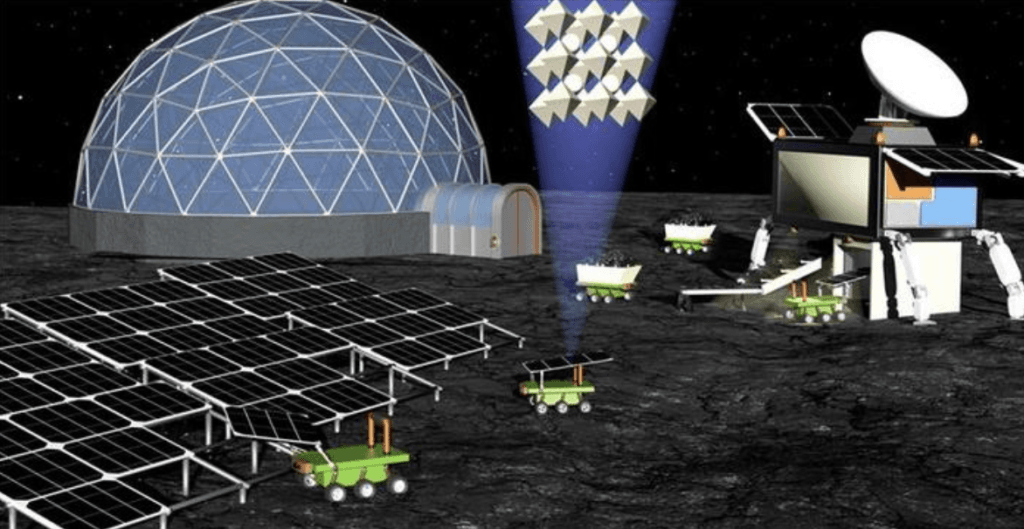Harnessing Moon Dust for Solar Energy: A Revolutionary Step Towards Sustaining Lunar Colonies

▼ Summary
– Researchers from the University of Potsdam have developed “moonglass” solar cells using synthetic moon dust (regolith) and perovskite crystal.
– These solar panels could be lighter, more cost-effective, and more resistant to radiation compared to current models used in space.
– Producing solar panels directly on the Moon using regolith could reduce launch mass by 99%, significantly lowering transportation costs.
– The best prototypes of moonglass solar cells have achieved approximately 12% efficiency, with potential to match conventional perovskite cells in the future.
– This development is part of broader efforts to establish sustainable human presence on the Moon, including 3D-printing habitats and extracting oxygen from regolith.
A groundbreaking development in solar technology could enable future lunar colonies to power their operations using solar panels crafted from the Moon’s own surface material.
Researchers from the University of Potsdam have successfully created “moonglass” solar cells by melting synthetic moon dust, known as “regolith,” and integrating it with a layer of perovskite crystal to form a functional solar panel.
According to the research team, these innovative solar panels could present several advantages over the current models used in space. They could be lighter, more cost-effective, and exhibit greater resistance to radiation. These findings were recently published in the journal *Device*.
At present, solar panels play a crucial role in powering satellites, space stations, and various rovers on Mars and the Moon, all of which are manufactured on Earth and then transported into space. However, as humanity moves closer to establishing a permanent presence on the Moon, the demand for solar power will significantly increase, thereby escalating the costs associated with transporting these panels.
Felix Lang, the primary author of the study, highlighted that although the silicon-based solar cells used in space today display impressive efficiencies of 30% to 40%, they come with a high price tag. These cells are also relatively heavy due to the glass or thick foil coverings they incorporate. “Transporting these cells into space is not cost-effective,” Lang remarked.
Utilizing the Moon’s regolith for solar panel production could revolutionize this process. By producing moonglass directly on the lunar surface and coating it with a thin perovskite layer brought from Earth, the researchers demonstrated that they could reduce launch mass by an astonishing 99%.
Solar Panel Fabrication on the Moon

The researchers noted that converting these materials into solar panels on the Moon would require minimal equipment, as the raw regolith does not need extensive pre-processing. They have already shown promising results by using a large curved mirror to focus sunlight into a beam hot enough to melt the regolith into moonglass.
While moonglass, derived from raw regolith, is milky-white rather than transparent, thus limiting its light absorption capabilities, the best prototypes developed by the Potsdam team achieved approximately 12% efficiency,roughly half that of traditional perovskite cells. However, simulations indicate that these moonglass cells could eventually match the efficiency of conventional perovskite cells.
Nicholas Bennett from the University of Technology Sydney acknowledged this achievement as the first successful application of moonglass in a working solar cell. He pointed out that the next significant challenge lies in producing large quantities of moonglass outside laboratory conditions.
Moonglass solar panels represent just one of many advanced technologies being explored to establish a sustainable human presence on the Moon. Other initiatives in the pipeline include using lunar dust to 3D-print habitats, developing systems for extracting oxygen from regolith, and constructing space mirrors to melt lunar ice for drinking water.
To witness a showcase of these space-age technologies, consider attending the TNW Conference on June 19-20 in Amsterdam. Tickets are currently available, and you can use the code TNWXMEDIA2025 at checkout to receive a 30% discount.
Note: Ensure to book your tickets in advance to join this groundbreaking event.
Source: The Next Web